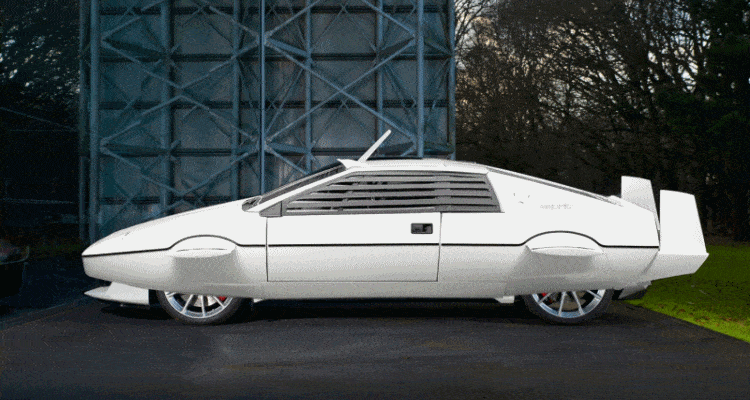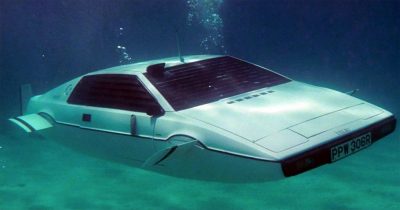With each new film, the James Bond brand introduces products that reflect its debonair image, from tailored suits to the latest luxury vehicles.
A recent example of this cross-industry collaboration is the Triumph Scrambler 1200 Bond Edition motorcycle, which was launched alongside the latest Bond film No Time To Die (2021). Featuring 007 logos, Bond Edition badging, and gold accents, this bike embodies the blend of luxury and function that is central to the Bond universe.
But beyond the expensive motorcycles, the James Bond films are best known for their stunning array of classic cars, which often take center stage in the films. What better way to complement these iconic vehicles than with equally stylish eyewear? Below, we take a closer look at four pairs of sunglasses that perfectly match four classic Bond cars.
Ray-Ban Wayfarer for the Aston Martin DB5
Credit: Aston Martin on YouTube.
The Aston Martin DB5 is arguably the most iconic James Bond vehicle. Featured in several films, including Goldfinger (1964) and Skyfall (2012), the DB5 is a British grand tourer known for its sleek design, powerful 4.0-liter inline-six engine, and, in the films, a range of various gadgetry, such as machine guns and an ejector seat.
Pairing the DB5 with the just-as-iconic Ray-Ban Wayfarer sunglasses makes perfect sense. First introduced in the 1950s, the Wayfarer helped popularize Ray-Ban sunglasses across the globe. This set the stage for several other Ray-Ban models that followed, such as the Clubmaster — much like the DB5 inspired the gadget-laden appearance of the Lotus Esprit and other succeeding Bond cars. Otherwise, the Wayfarer’s simple yet bold design, including a distinct trapezoidal shape and sturdy acetate frame, complements the DB5’s elegant and enduring style.
Persol 649 for the Lotus Esprit S1
Credit: Movieclips on YouTube.
Next up is the aforementioned Lotus Esprit S1, the agile sports car that famously transformed into a submarine in The Spy Who Loved Me (1977). With its sleek, wedge-shaped design by Giorgetto Giugiaro and fiberglass body, the Lotus Esprit S1 was powered by a 2.0-liter inline-four engine that delivered nimble performance on land and under the sea.
To match the unique charm of the Lotus Esprit S1, look no further than the Persol 649. Persol sunglasses are a consistent feature in Bond movies, famously donned by Pierce Brosnan in GoldenEye (1995) and Die Another Day (2002). The brand’s relaunch of the signature 649 in 2024 offers a contemporary twist on a classic. The 649’s unique acetate frame, Barberini premium glass lenses, and tone-on-tone Supreme arrows make them an excellent companion for a car that’s as adventurous as it is elegant.
Oliver Peoples Gregory Peck for the BMW Z8
Credit: Cars and Movies on YouTube.
The BMW Z8, driven by Pierce Brosnan in The World Is Not Enough (1999), was a fitting choice for Bond’s 90s-era style. With its sleek roadster design, the Z8 boasted a powerful 4.9-liter V8 engine and an aluminum chassis that made it both fast and agile. Its advanced technology — like the titanium armor and remote driving capabilities — cemented its status as one of the Bond vehicles’ more modern classics.
Pair the BMW Z8 with the Oliver Peoples Gregory Peck sunglasses for a refined and intellectual look. Inspired by the glasses worn by Gregory Peck in To Kill a Mockingbird (1962), these shades remain a favorite among modern stars like Channing Tatum, who donned the Oliver Peoples shades while promoting Blink Twice (2024).
Their minimalist design and lightweight structure make them a sophisticated choice that perfectly complements the sleek and polished aesthetic of the BMW Z8, whether you’re speeding down the highway or attending a gala.
Giorgio Armani Aviator for the Aston Martin V8 Vantage
Credit: James Bond 007 on YouTube.
The Aston Martin V8 Vantage, featured in The Living Daylights (1987), is known for its muscular design, powerful acceleration, and 5.3-liter V8 engine. With its missile launchers, retractable skis, and bulletproof glass, the V8 Vantage combines luxury with adventure in a way only Bond could manage.
Of course, none other than the Giorgio Armani Aviator sunglasses is the perfect match for the classic V8 Vantage. Known for their lightweight metal frames, teardrop shape, and timeless style, these sunglasses offer an understated elegance that sets them apart from the Ray-Ban aviators famously worn by Tom Cruise in his own film franchise, Top Gun (1983; 2022). This pairs beautifully with the bold yet refined lines of the V8 Vantage, adding a touch of sophistication whether you’re behind the wheel of a Bond car or simply enjoying a sunny day.
Whether you’re channeling the timeless cool of a DB5 or the futuristic flair of a Lotus Esprit S1, there’s a pair of sunglasses to match every classic Bond car. For more on luxury and racing cars, check out our other write-ups on Car Revs Daily.

CRD Auto Industry Insider may contain helpful and on-topic partner content that auto enthusiasts and car shoppers find valuable.
























